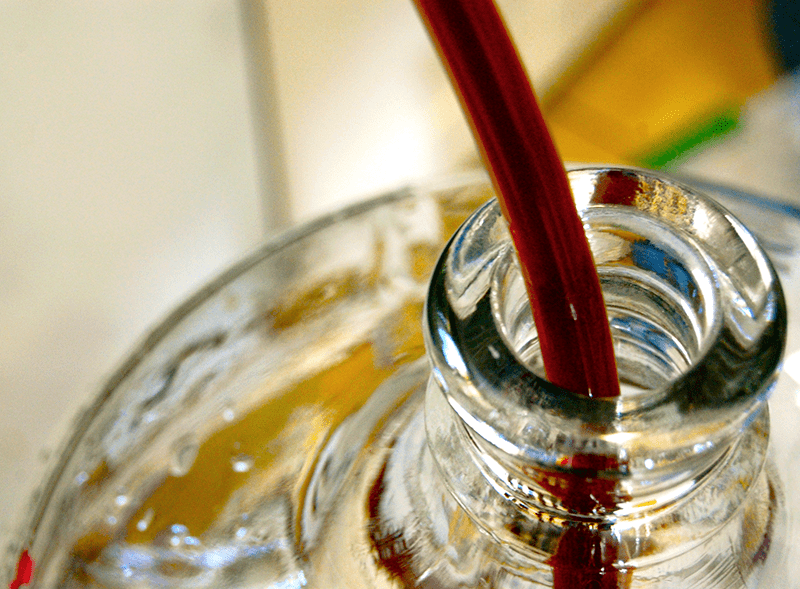 There’s an old adage when it comes to making your own beer:
There’s an old adage when it comes to making your own beer:
Ask ten homebrewers one question and you’ll get eleven different answers.
For such a unique, do-it-yourself hobby, there are all sorts of ways to approach homebrewing with just as many opinions and processes to consider. But for me, one area stands out as clear as a golden pilsner. I always rack my beer into a secondary fermentation.
It’s a step that may not be completely necessary for every beer you brew, but between habit and success, I’ve made a secondary fermentation a regular part of my brewing process. I believe it’s an effort worth the minimal investment in time – about an hour to transfer and clean up – especially since you just need a second fermentation vessel to pull it off.
So what is a secondary fermentation, anyway? It’s very simple. A secondary fermentation is done by moving your beer to a another fermenter towards the end of fermentation. This could be anywhere from the 3rd to 7th day. Ideally, leave your beer in secondary fermentation for at least one week, but feel free to add more time if additional ingredients are added for flavor.

So why should you consider putting your beer in a secondary fermentation?
Here are three good reasons to put your beer through a secondary fermentation:
- Manipulate the flavor of your beer
Because primary fermentation can be rather vigorous and even violent, it’s not worth adding additives/adjuncts to your beer right away. A secondary fermentation offers the perfect time to add fruit, wood, or other flavorings to provide layers of complex flavor to your beer. You’ll be able to maximize taste and aroma without the threat of losing anything. Of course, this is the right time to dry hop, too, which allows all the oils of the hops to be transferred directly into your beer instead of getting boiled off in the wort on brew day. Get all the hoppy characteristics you look for without adding bitterness.
- Improve the taste

Leaving beer on a collection of trub for too long can start to negatively impact the taste of your beer, maybe even creating off-flavors from autolysis. Racking your beer to a secondary fermenter can prevent this. On the flip side, moving a secondary fermentation will give the yeast one more chance to chew up the intricate sugars floating around in your beer, to clean up potential off-flavors (like diacetyl), and help flavors meld together.
- Get a clearer beer
You can use Irish moss or Whirfloc tablets in the boil, but post-brew day, another easy way to clarify your homebrew is to get it off remaining yeast and trub from primary fermentation and allow it to condition a little longer in a new carboy. It also means less sediment to deal with once you’re ready to bottle your homebrew. If you make lots of darker beers, including porters or stouts, doing the two-stage fermentation may not be as necessary. But since I make many lighter beers like IPAs, wheat ales and even a blonde now and then, it matters a lot.
The Bottom Line…
Putting your beer through a secondary fermentation does mean you have to spend a little more time with it (about an hour), and if you’re not thorough in sanitation there is chance for infection. However, in the grand scheme of things, your beer will more often than not look and taste better in the end.
—–
Bryan Roth is a beer nerd and homebrewer living in Durham, North Carolina. You can read his thoughts on beer and the beer industry on his award-winning blog, This Is Why I’m Drunk, and send him suggestions on how to get his wife to drink craft beer via Twitter at @bryandroth.

For me I think you risk getting to much oxygen in your beer when doing a secondary fermentation , having said that I used to do it myself for a number of years with little trouble, but now use the two two two method ( 2 weeks fermenting , two weeks in bottle or keg after priming, in the same room where primary fermentation took place , 2 weeks somewhere much cooler to condition) always works well for me and is the best method I have found in forty years of brewing. Cheers
Hence, his preface of asking 10 homebrewers a question and getting 11 different answers.
For anyone who comes across this article, I wanted to share that I have found secondary fermentation to elicit the described benefits the author mentions. To me, when I employ a secondary, the beer always seems to turn out ‘cleaner’ both in appearance, and more importantly, taste.
Being careful with cleaning and sanitation, and with the racking process, there is very little to fear in terms of introducing oxygen or running into other contamination problems. The additional yeast action also forces the oxygen out of the secondary vessel (my airlock will bubble gently for several hours after transferring), and generally clean things up nicely.
Ultimately, I would never tell anyone they ‘should’ do anything if they’ve already tried multiple methods several times and want to stick with what seems to give them the best results. For me, though, I have gotten better beer more consistently when using a secondary.
I also secondary ferment, but do not add anything to the carboy. Do you have any suggestions for additives? I usually brew Pale ale. Thanks.